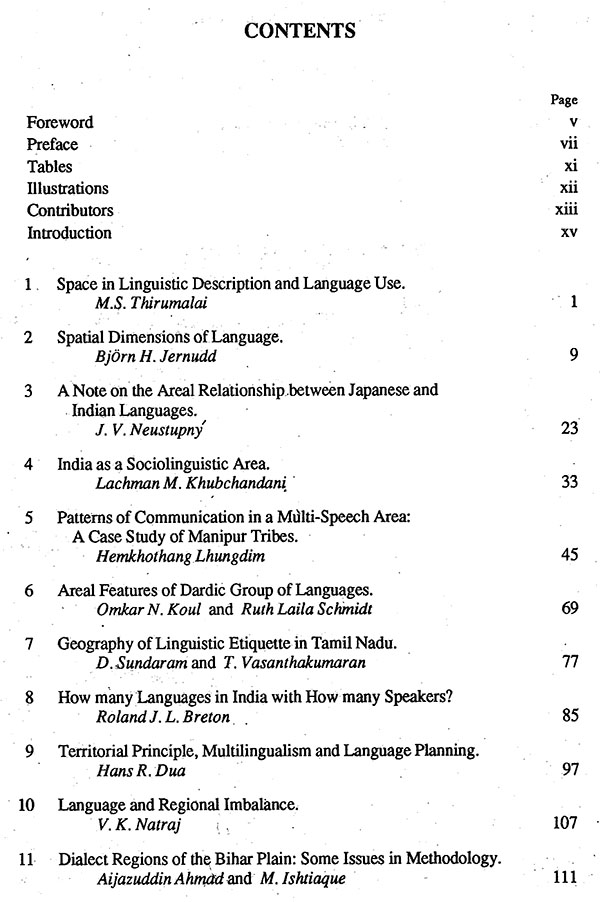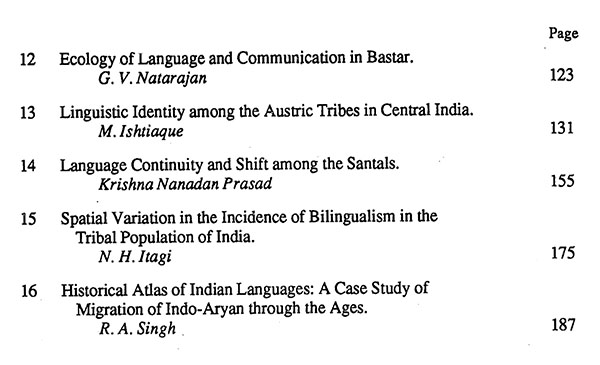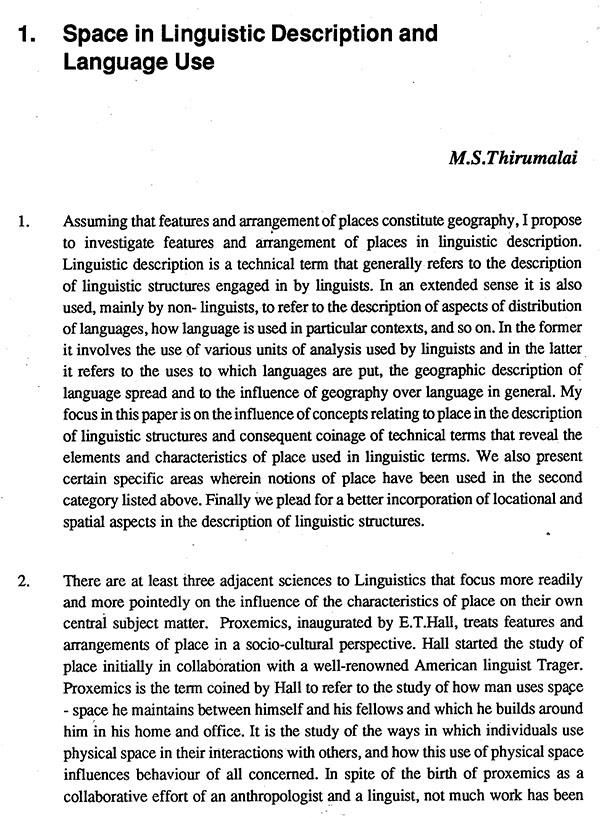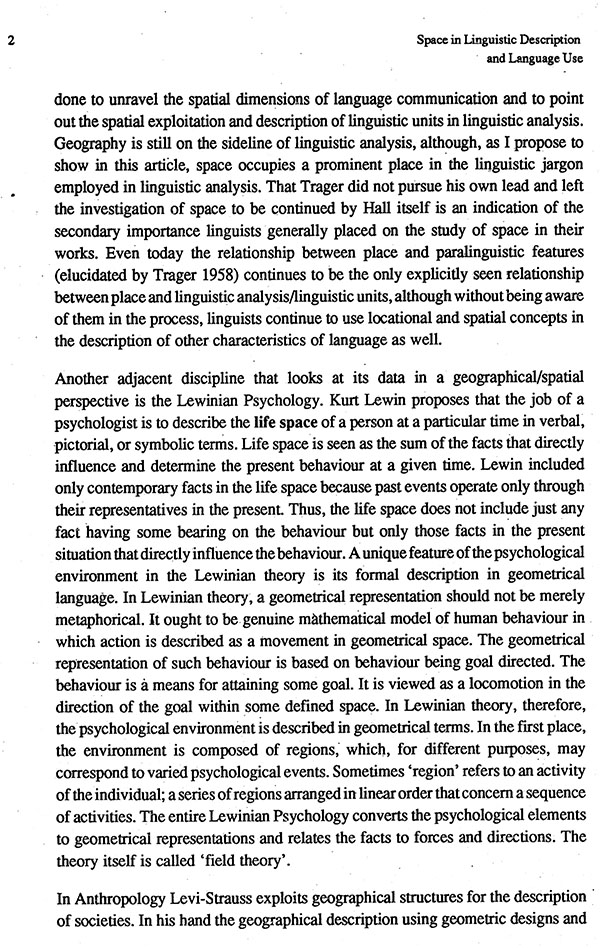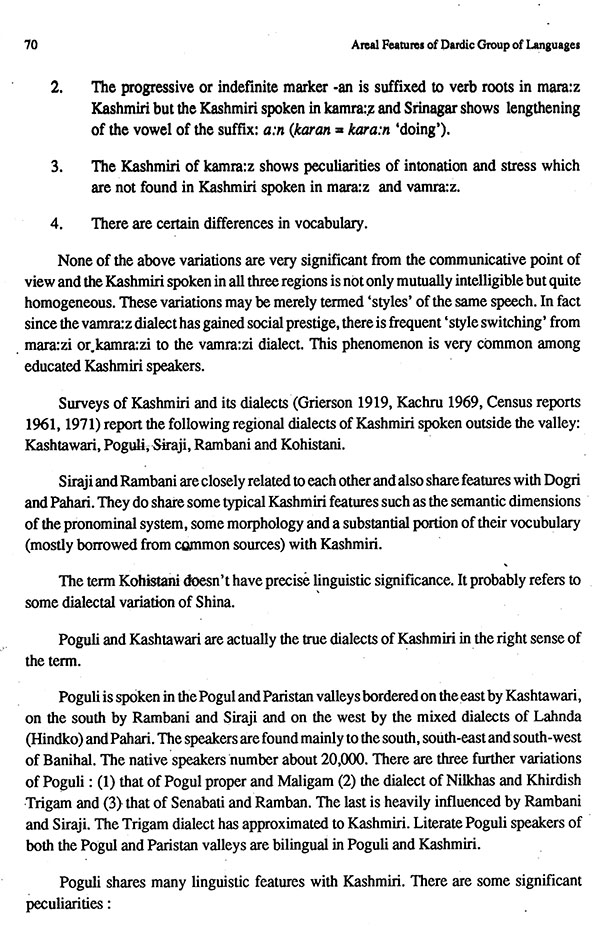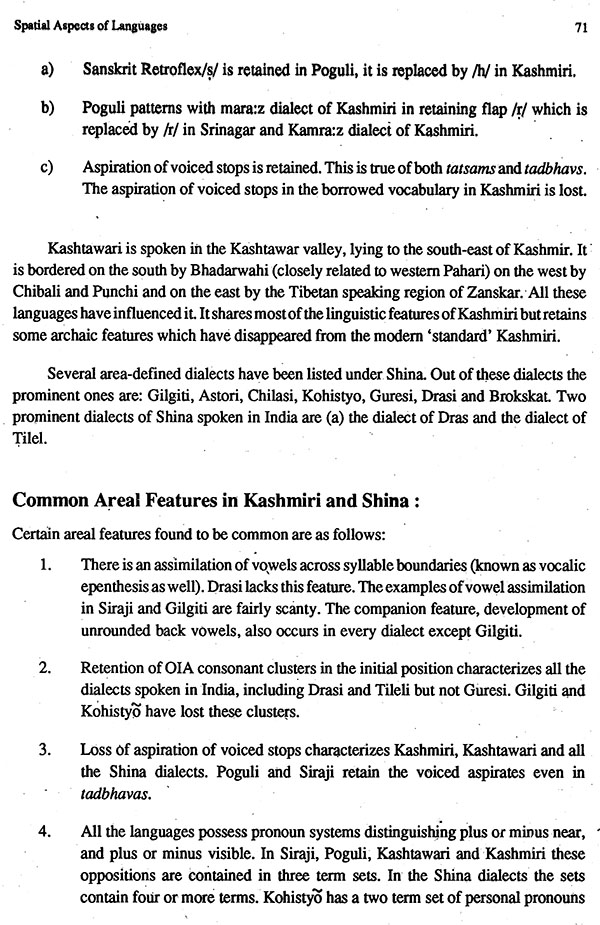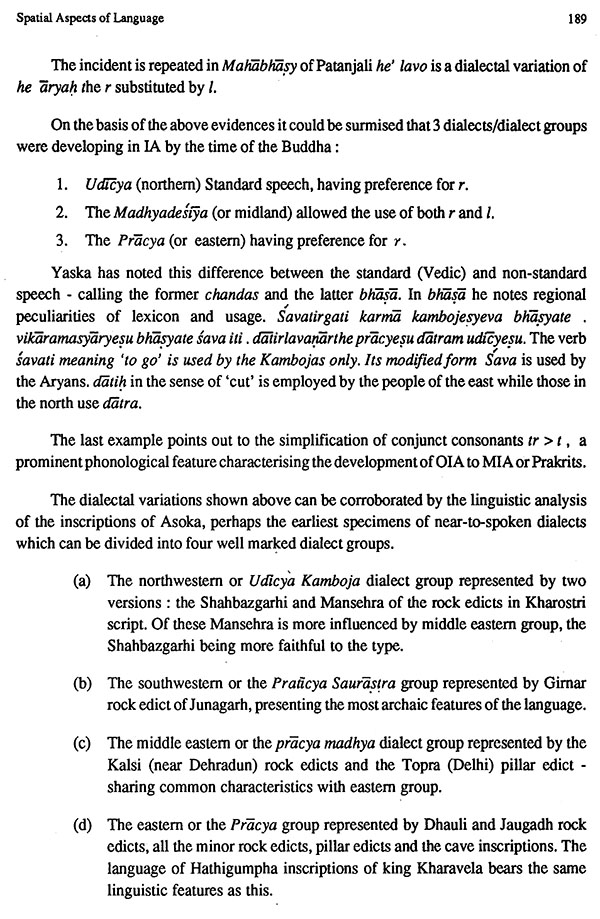
Spatial Aspects of Language
Book Specification
| Item Code: | NAX316 |
| Author: | N.H. Itagi |
| Publisher: | Central Institute Of Indian Languages, Mysore |
| Language: | English |
| Edition: | 1994 |
| Pages: | 196 and 21 Maps |
| Cover: | PAPERBACK |
| Other Details | 10.00 X 7.00 inch |
| Weight | 350 gm |
Book Description
The language exists in space, physical and social, while the grammar exists in the mind. Any delimitation of language is done in spatial terms in the sense that language boundaries are drawn spatially in physical and social terms in view of the fuzziness of grammatical boundary between languages. The study of language in space, therefore, is inherent in the linguistic study.
There is two fold relationship between space and language. One is categorisation of space in language. The grammatical study of spatial terms and diectic categories in language is very old. Recently, with the emphasis on the cognitive aspects of language and, grammar, the differences between languages in categorisation and expression of space and the extent of their grammaticalisation, have attracted linguists, anthropologists and cognitive psychologists to the study of space in language.
The other aspect is language in space. Dialect geography is very old. Sociolinguistics extended the study of variation into social space. The study of language spread geographically and demographically has received attention in sociolinguistics in the recent past. The study of language change and language typology has added the areal dimension giving birth to areal linguistics, in which the study of languages in India 1s a pioneering one. It is now well recognised that languages share features not only due to genetic and typological relation but also due to the fact that they are distributed over a geographical area where linguistic communities are in close contact.
The varied relations between space and language as indicated above do not have a common name and the name of geolinguistics will have to be defined very broadly to subsume all these aspects.Nevertheless, the different theoretical paradigms and ~ methodologies calling into question whether geolinguistics is a unified discipline. It can be a sub-discipline in the same way as sociolinguistics in the sense of defining a subject matter viz. the two-fold relationship between language and space.
The papers in this volume deal with many of the aspects of this relationship. It 1s hoped that this volume will generate further inter-disciplinary research in this area and perhaps will lead towards a more unified approach to the study of this subject.
The Central Institute of Indian Languages has reached 25 years of age and it is a time for reflection about its origin, development, achievements and shortfalls.
The study of Indian languages with the objective of preparing them for the new roles of national reconstauction and development was the concern of many from the independence of the country. The major responsibility to support such a study was to be taken up by the State. The Kher Commission of the Government of India recommended the establishment of three Central Institutes for this purpose. The Official Language Resolution of 1968 made the Central Government also responsible for the development of all Indian languages in addition to Hindi. These and other developments led to the establishment of Central Institute of Indian Languages (CIIL) in Mysore on July 17, 1969.
The primary objective of the Institute is the development of Indian languages ensuring coordination between the various developmental activities at the governmental and non governmental levels and also by orienting linguistic research for the development of Indian languages. The Institute is also to contribute towards the maintenance of multilingualism of the country through language teaching, and translation and to strengthen the common bond between the Indian languages.
The work of the Institute consists of research, training and production of teaching materials. The results of these activities can be seen in its more than 300 publications and 6879 teachers trained in its Regional Language Centres. The Institute has been able to make an impact in language teaching in schools making it skill based and function oriented. It has brought audio visual and computer technology to aid the teaching of Indian languages. It has helped many tribal languages to be codified, described and used in education. Its research and training programmes in social, psychological and folkloristic aspects of language and culture have introduced new dimensions to research on Indian languages. The Intemational Institutes organised by the Institute in sociolinguistics, semiotics, phonetics and other areas have helped the development of human resource in these areas.
The major problem of the Institute is that it cannot meet all language needs of the whole country. It has to play the role of a catalyst and modelsetter. The other agencies are to take over the universal implementation of the innovations. This has not taken place to the desired extent.
In the coming years, the Institute plans to consolidate the earlier work and expand the work in the ares of translation, computer applications and production of audio visual materials. It wishes to strike new grounds in language evaluation and storage and dissemination of language information. The Institute will move into anew Campus to carry on the work with new vigour and vision.
One part of the Silver Jubilee Celebration is the publication of 25 special volumes. The present book is one of these volumes.
Spatial Aspects of Language is essentially a collection of some of the papers of the seminar on ‘spatial dimensions of language and linguistic communication in India’ which was organised by the Central Institute of Indian Languages in December 1987. The seminar was organised with a view to explore and highlight the spatial dimensions of language, speech communities and linguistic communication in India.
The interest in spatial variation and association with regard to language has varied from one of across languages (Comparative Linguistics/Philology, Contrastive Linguistics, Typological Linguistics and Areal Linguistics) on the one hand to within a language (Dialect Geography/Linguistic Geography). Of late, there has been increasing interest in language and spatial cognition, and how different linguistic and cultural groups cognize space.
Interestingly though one of the main concerns of modern geographers has been the study of spatial organization - how and why people organize space as they do - it has preceded or proceeded unaware of the study of spatial cognition and the role of language in it. Language has not been a frame of reference so far in the study of spatial organisation. In fact, language has not been, until recently, a matter of content of geographical inquiry. Though geographical thought is concerned with variation and the various association of different phenomena over the surface of the earth, the ’various phenomena’ - both physical and social - of geographers’ study has been, by and large, devoid of language. Of late, many geographers are becoming increasingly aware of and interested in language and owing to the interest in spatial aspects of language and the ‘processes of spatial dynamics on the part of linguists and the addition of language to the content of geographical thought and inquiry, a new discipline of geolinguistics is emerging.
The following themes suggested for the seminar and to which some of the papers ° of that seminar pooled together in this collection are addressed to by linguists, geographers, language planners, regional planners and sociologists, may form the subject matter of the new field of geolinguistics of India.
- Language distribution and its geographical correlates.
- Typology of language distribution in a geographical sense, e.g., core vs. periphery, homeland vs. immigrated land, contiguous vs. non-contiguous, etc.
- Language variation - regional isoglosses. .
- Linguistic diversity.
- Bilingualism - spatial aspects of its extent on rural - urban axis, zones of contact and spatial spread of link languages.
- Spatial patterns of interlingual communication and communication potential.
- Language and region formation.
- Diffusion and spread of linguistic features and languages.
- India as a linguistic area and communication area.
Spatial Studies of Language by BjOrn H. Jernudd deals with the foundations on which the spatial studies in relation to language could build upon and the direction in which they could move. He points out that so far only two sub-fields of Linguistics namely Dialectology and Areal Linguistics focussed on spatial aspects of language and here too the concern was space and the issues related to the difference between language and dialect but not to the spatial processes. In Geography, on the other hand, there are a number of theoretical models dealing with spatial process but not related to language e.g. Hagerstrand’s model of diffusion of innovations, Roger’s model of communication diffusion dealing with rural extension services, Christaller’s central place theory, the gravity model, etc. Spatial studies could benefit by moving in the direction of these chorological models. As he also points out that the study of migration and its consequences on language is another aspect of spatial concern to language which is exemplified in an article Historical Atlas of Indian Languages: A Case Study of Indo-Aryan through the Ages by R. A. Singh. Space in Linguistic Description and Language Use by M. S. Thirumalai points out to some of the areas such as linguistic description and language use which could be and are analysed in locational and spatial terms and concepts while D. Sundaram and T. Vasanthakumaran point out through their article Geography of Linguistic Etiquette in Tamil Nadu that linguistic behaviour in terms of politeness expressions, respect relations, etc. could be studied within a spatial frame.
